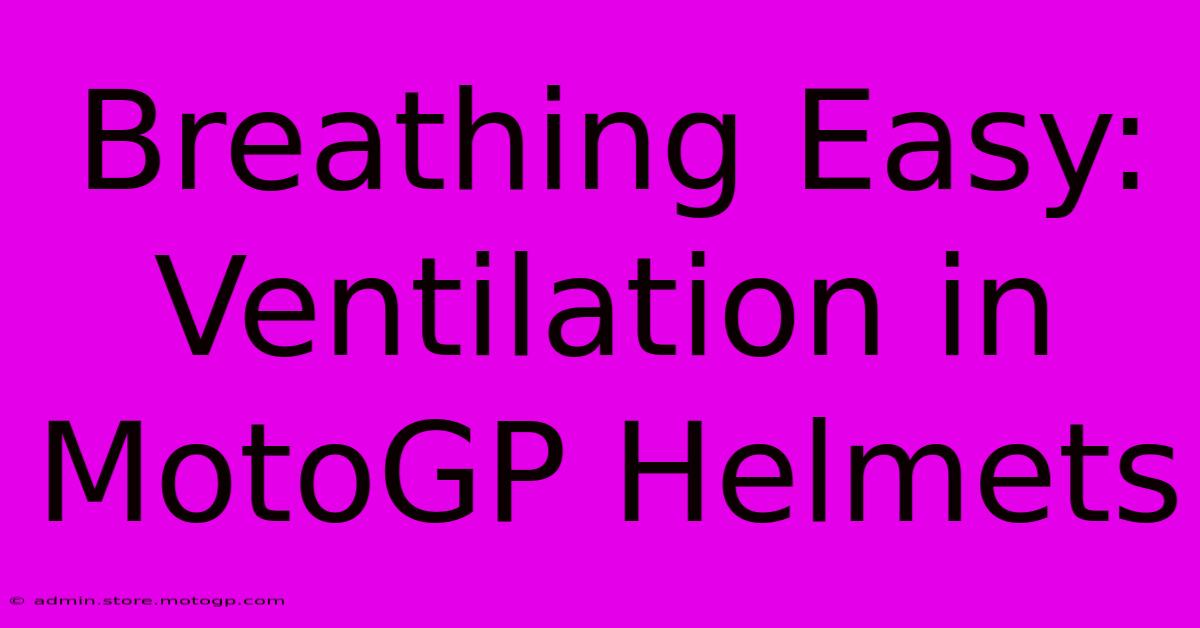Breathing Easy: Ventilation In MotoGP Helmets

Table of Contents
Breathing Easy: Ventilation in MotoGP Helmets
MotoGP racing pushes riders and their equipment to the absolute limit. While speed and skill are paramount, the rider's comfort and safety are equally crucial. One often-overlooked aspect is helmet ventilation. In the intense heat and physical exertion of a race, proper ventilation isn't just a comfort feature – it's a performance enhancer and a vital safety consideration. This article delves into the sophisticated ventilation systems found in MotoGP helmets, exploring the technology and engineering that keeps riders breathing easy under pressure.
The Importance of Helmet Ventilation in MotoGP
The extreme conditions faced by MotoGP riders demand exceptional helmet ventilation. Think about it:
- High Temperatures: Engine heat, track surface radiation, and the rider's own body heat create incredibly high temperatures within the helmet.
- High Physical Exertion: MotoGP riders push their bodies to the limit, generating significant sweat and heat.
- Concentration: Overheating can lead to fatigue, reduced concentration, and impaired judgment – factors that can have serious consequences at those speeds.
- Fogging: Moisture build-up can fog the visor, dramatically reducing visibility and increasing risk.
Poor ventilation translates directly into compromised performance and increased safety risks. A well-ventilated helmet, however, helps maintain a comfortable internal temperature, prevents fogging, and keeps the rider alert and focused.
Beyond Basic Vents: Advanced Ventilation Technology
MotoGP helmet ventilation is far more complex than simple air inlets and outlets. Manufacturers employ sophisticated aerodynamic principles and materials science to maximize airflow and minimize turbulence.
- Computational Fluid Dynamics (CFD): CFD modeling helps engineers optimize the placement and shape of vents to create efficient airflow pathways. This ensures air is directed effectively across the rider's face and head.
- Multi-Channel Ventilation: Many high-end helmets feature multiple channels within the EPS liner, guiding air throughout the helmet for optimal cooling.
- Aerodynamic Design: The shape and design of the helmet shell itself play a crucial role in ventilation. Efficient airflow over the shell reduces drag and helps draw air into the ventilation system.
- Chin Bar Vents: These strategically placed vents pull air in from the front, cooling the rider's face and mouth.
- Rear Exhaust Ports: These vents work in conjunction with internal channels to extract hot, humid air, creating a constant flow of fresh air.
- Adjustable Vents: Many MotoGP helmets feature adjustable vents allowing riders to customize airflow based on track conditions and personal preferences.
The Materials Matter: Lightweight and Breathable
The materials used in MotoGP helmets are critical to their ventilation performance. Lightweight, high-strength carbon fiber shells are preferred for their excellent strength-to-weight ratio and ability to resist heat transfer. The inner liner materials often feature breathable fabrics to wick away sweat and moisture, further enhancing comfort and ventilation.
Safety First: Ventilation and Impact Protection
It's important to note that helmet ventilation is not simply a comfort issue; it's intrinsically linked to safety. The complex airflow dynamics involved in effective ventilation necessitate robust helmet construction to withstand impacts. The design must ensure that ventilation features do not compromise the structural integrity of the helmet.
Conclusion: Breathing Easy for Peak Performance
Effective helmet ventilation is not merely a luxury in MotoGP; it's a critical component that directly impacts rider safety and performance. The advanced engineering, aerodynamic design, and high-performance materials employed in MotoGP helmets demonstrate the importance placed on this often-overlooked element of rider equipment. The constant pursuit of improvement in helmet ventilation reflects a commitment to ensuring riders can push their limits while staying cool, comfortable, and safe. The result? Riders breathing easy, pushing the boundaries of speed and skill on the track.

Thank you for visiting our website wich cover about Breathing Easy: Ventilation In MotoGP Helmets. We hope the information provided has been useful to you. Feel free to contact us if you have any questions or need further assistance. See you next time and dont miss to bookmark.
Featured Posts
-
Analyzing F1 Ratings Trends And Insights
Feb 18, 2025
-
Reach Unbelievable Speeds Moto Gp Bike For Sale
Feb 18, 2025
-
Get Ready For Thrills F1 Qualifying At Cota
Feb 18, 2025
-
Sprint Race Time Clear Your Schedule Now
Feb 18, 2025
-
Cota One Day Pass Seamless Columbus Exploration
Feb 18, 2025
